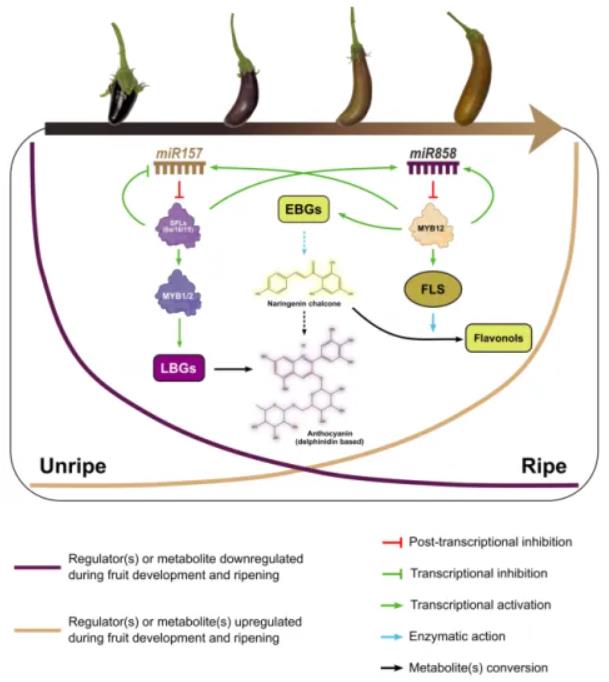Recently, Sayantan Panda and Asaph Aharoni's team from the Weizmann Institute of Science in Israel published a research paper titled "Molecular Mechanisms Driving the Unusual Pigmentation Shift in Eggplant Fruit Development" in Plant Communications. The authors conducted in-depth research from the aspects of metabolites, gene expression, transcriptional regulatory networks, etc., and discovered its unique regulatory mechanism, which provides a key basis for the study of fruit pigment regulation and eggplant quality improvement.
In most fleshy fruits, chlorophyll accumulates in the early stage of development and is replaced by other pigments when mature, such as grapes and strawberries that accumulate anthocyanins. Eggplant, as a non-climacteric fruit, has unique pigment changes. Early fruits accumulate anthocyanins from the peel, which are replaced by naringenin chalcone in the later stage. However, the molecular regulatory mechanism of eggplant fruit pigment changes is still unknown.
Using ultra-high performance liquid chromatography-mass spectrometry (UPLC-MS), it was found that all varieties accumulated yellow and brown pigments at the ripening stage, and the accumulation of naringenin chalcone in the epidermal tissue of mature fruits increased significantly.
At the same time, the content of purple anthocyanins gradually decreased during the ripening process. In the study of eggplant breeding line DR2 fruit, it was further confirmed that from 3WPA to 11WPA, the content of four anthocyanins gradually decreased, the content of naringenin chalcone began to increase from 7WPA, and other flavonoid pathway intermediates such as naringenin and kaempferol derivatives also gradually increased.
These results indicate that pigment accumulation has undergone a significant shift during eggplant fruit development, and the biosynthesis of anthocyanins and naringenin chalcone is independent of each other to a certain extent.
By analyzing the mRNA and miRNA sequencing data of DR2 fruit epidermal tissue at four developmental stages, 41 miRNAs were identified that may target 31 mRNAs. Among them, miRNA157 and miRNA858 target SPL family transcription factors (SmSPL6a, SmSPL10 and SmSPL15) and MYB12 transcription factors, respectively, and qRT-PCR verified the negative correlation between them.
Dual luciferase assays further demonstrated that miRNA157 and miRNA858 regulate fruit flavonoid metabolism at the post-transcriptional level by regulating SPL and MYB12 mRNA.
Overexpression of miRNA858 significantly reduced MYB12 transcription levels, while overexpression of SmMYB12 alone induced endogenous miRNA858 transcription. Eggplant plants overexpressing miRNA156 and miRNA157 had significantly reduced early purple fruit and turned white, and mature fruits were mostly yellow with a slight lavender color. Analysis of the fruits of the miRNA157 overexpression line revealed that the four main anthocyanins were significantly lower than those of the wild type at all developmental stages, while the accumulation of naringenin chalcone and some kaempferol derivatives was higher at 7-9 WPA.
In addition, SPL6a, SPL10 and SPL15, as transcriptional activators, activated genes in the anthocyanin biosynthesis pathway by regulating MYB1 and MYB2, regulating anthocyanin synthesis. At the same time, miRNA157 negatively regulated SPL expression and was transcriptionally inhibited by SPL; miRNA858 negatively regulated MYB12 and was transcriptionally activated by MYB12.

Figure 1. Molecular mechanism of changes in eggplant fruit epidermal pigment regulated by miRNA157 and miRNA858. (Panda, et al., 2025)
In summary, this study revealed that the accumulation of anthocyanins and naringenin chalcone in eggplant fruit development was synergistically regulated by miRNA157, miRNA858, SPL, MYB and other transcription factors, laying a theoretical foundation for eggplant quality improvement.